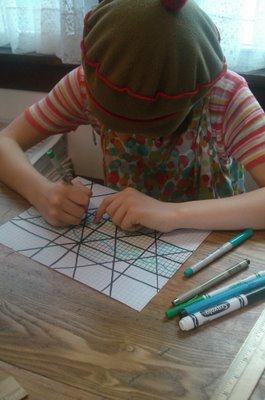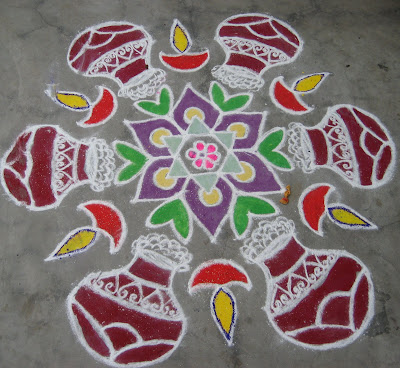Abby's Art Club
A DIY blog about starting an art club for kids and finding the inspiration to keep it going.
Tuesday, March 27, 2007
ukrainian easter eggs
This is our second year making Ukrainian Easter Eggs. The dyes are vibrant and inspiring to work with even if you don't plan on using traditional wax resist techniques. In Madison I got the dyes, wax, and kistkas (wax funnel drawing tools) at Orange Tree Imports on Monroe Street. One year I ordered supplies online from The Caning Shop and was very happy with their service.
Henry is demonstrating the wax removal technique. The most magical part of Ukranian egg dying is removing the outer wax coating and seeing the vibrant colors preserved underneath.
Annalise is enraptured by her kistka. Using a kistka is really quite hard, especially the cheaper versions that we use. The wax tends to blob and flow in strange and unexplainable ways. I just encourage the kids to choose simple designs and accept the difficulty of drawing with wax. When you look at traditional Ukrainian egg design it is easy to get discouraged by the emphasis on minute details. We are always able to come up with beautiful eggs, but we just try not to focus on perfection.
Linnea's little gerbil egg.
Tuesday, March 20, 2007
chalk drawings
Annalise and Carina combine the early spring enthusiasm of bare feet with hats and polar fleece.
We marked the coming of spring by going outside and creating mandala like chalk drawings on the sidewalk. We were inspired by photographs a friend took in India, and the fact that we had a sunny day above fifty degrees.
chalk drawings
My friend Jessica took these photographs in India. They show chalk drawings made for a spring agricultural festival called Pongal. These chalk drawings are placed in front of entryways and mark hopes for a bountiful harvest.
I was interested in seeing how the chalk drawings begin with a grid of dots. I had the kids use this technique to keep track of the balance of their designs and it seemed to help. Also, they are using some sort of colored powder instead of chalk. They apply the powder to a wet ground with their fingers and get a most vibrant and intense color that we were not able to duplicate with our simple chalk sticks.
chalk drawings
We started class by looking at Jessica's photographs from India. I showed them some mandala designs and talked about balance and proportion. I had students work out some designs on graph paper that would capture the coming of spring in mandala form.

I had the kids pair up and work together on their outside chalk drawings. We started by using rulers to measure dots on the sidewalk and tried to replicate our original designs the best we could. Sidewalk bumps, mud, group dynamics, and the pure distraction of being outside made this a bit less than the meditative exercise I was imagining, but nonetheless, the kids came up with some good works. Now we need a bit more spring. The kids were barefoot, but I was still freezing.
Monday, March 12, 2007
abstraction in felt
Here are some of the kids' explorations in felt. They turned out pretty great. In the future I must remember to look at my fabric scraps for inspiration and save all felt bits.

Olive's underwater setting sun scene is an excellent example of the "more is more" school of abstraction.
Leaf's red faced man has purple buck teeth and a crown -- simply delightful caricature.
Isak's sweet ballet dancer was never glued down. He ended up scraping the dancer and moving on to work with a square grid pattern.
Linnea's lily pads float about in various spring colors.
abstraction in felt
The art club had some tiny felt scraps to play with today. Olive's mom (the hat maker) donated her scrap bin. The little felt bits were just oddly shaped enough to inspire quirky felt abstractions full of wonder and delight. Is it a landscape, a ship, or an exploding planet? Who can tell? I only passed out the glue during the second part of the day so students would have ample time to move the colorful felt bits around in various positions before anchoring them down with Elmer's glue for a finished work.
Tuesday, March 06, 2007
abstraction
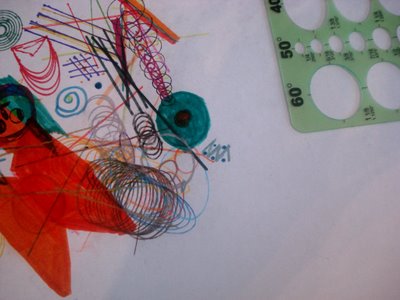
Today was the first day of our abstraction exploration. I got out the grid paper, markers, rulers, large paper, stencils, and pencils. We started class with a short discussion of abstraction, focusing on the repetitive patterning we found in the student's clothing. Olive had on the most wonderful outfit -- striped pink horizontal sleeves underneath a smock of intersecting circles with an peek-a-boo slip of gray vertical stripes and hot pink tights. Jimmy was sporting wide horizontal stripes of black and yellow on his shirt and narrow horizontal green stripes on his pants. We talked about the tension created by Jimmy's two patterns and the break at his midsection. I introduced the concept of white space and breaks in patterning by looking at the kids' outfits and it seemed to resonate. They were walking canvases!
I asked the students to play with the materials and create sketches that explored line, color and patterning in a variety of different ways. I put the music on loud and asked them to hold back sharing and talking during class so we could get away from the world of meaning and play with marking up the paper without a lot of premeditated thinking.
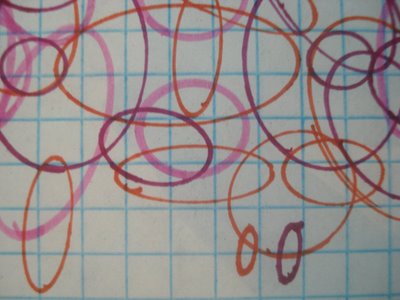

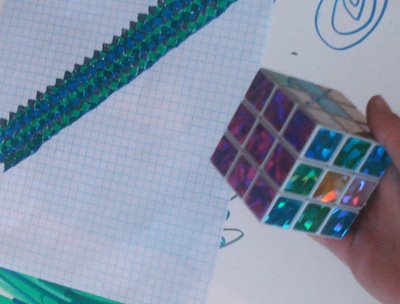
abstraction
The students practiced their abstract sketches in a quiet, almost meditative state. I played some Brian Eno (Music for Films) and at times you could hear nothing else. We broke at the end of an hour or so and talked about the sketches. Some of the kids wanted to give a title or some background context to their work, while others just talked about their process (I used the stencils, I was playing with grid paper, I limited myself to four colors). The kids who were working on patterning talked about eye fatigue and I took the opportunity to introduce the genre of Op art. I found some examples of Op art online and certain kids claimed to feel a bit sick after looking at the Op. Towards the end of the day many of the students got silly and needed a sort of hysterical release from the trance of abstract art we were under. Other students appeared to have a higher tolerance for the altered state of repetitive mark making and lost all track of time.
